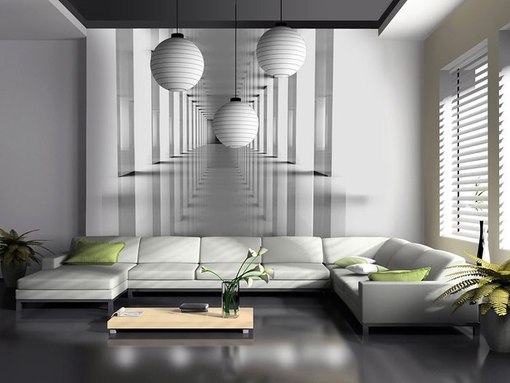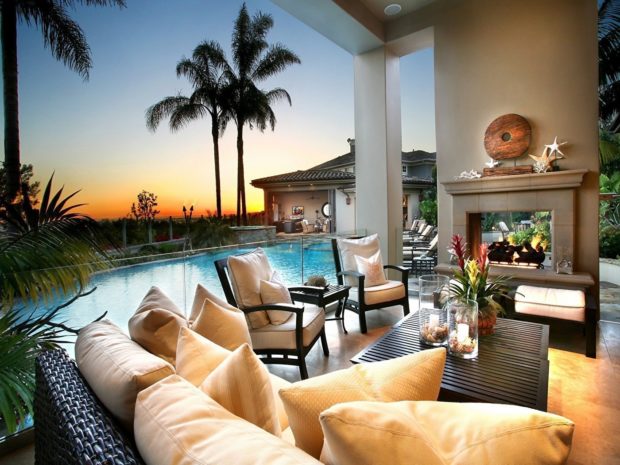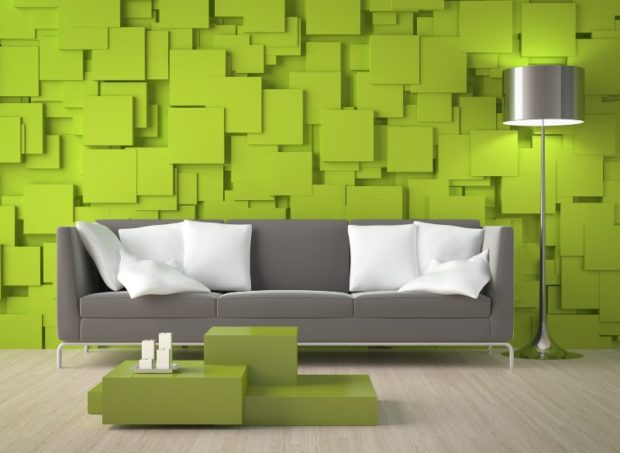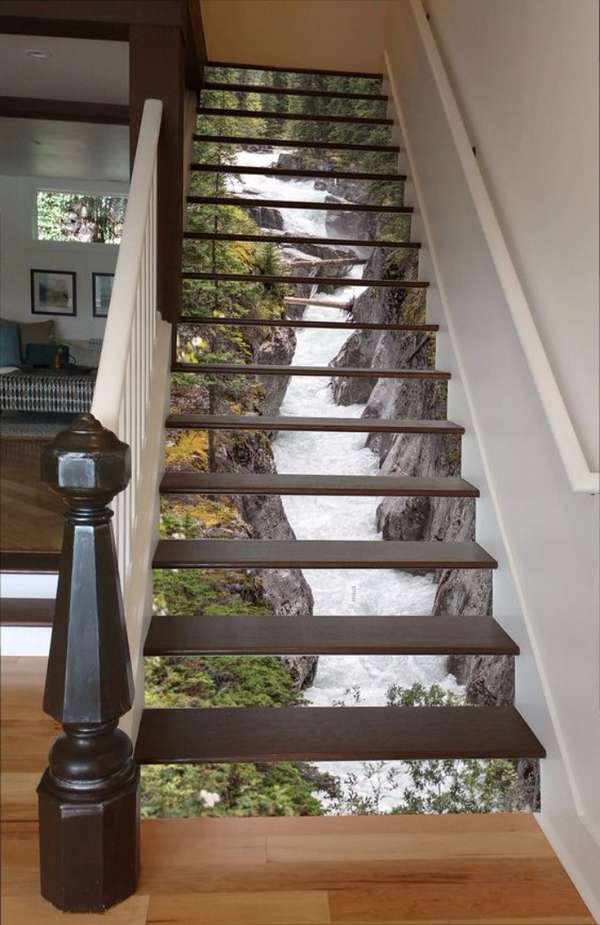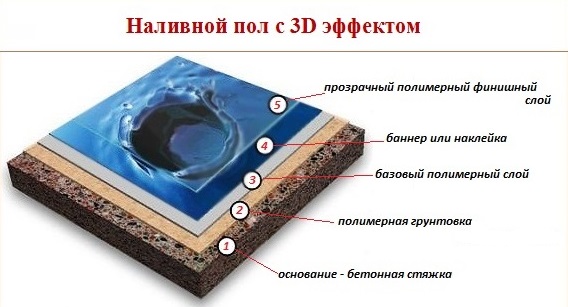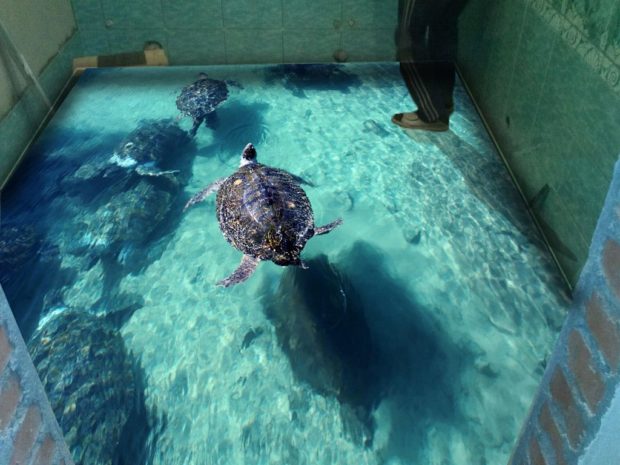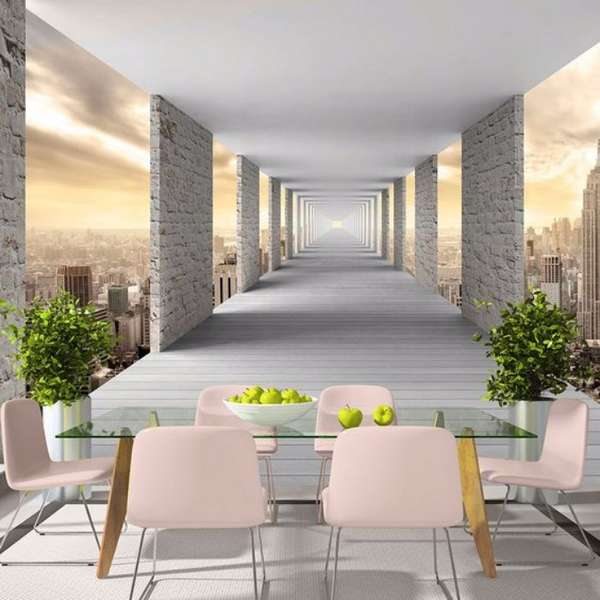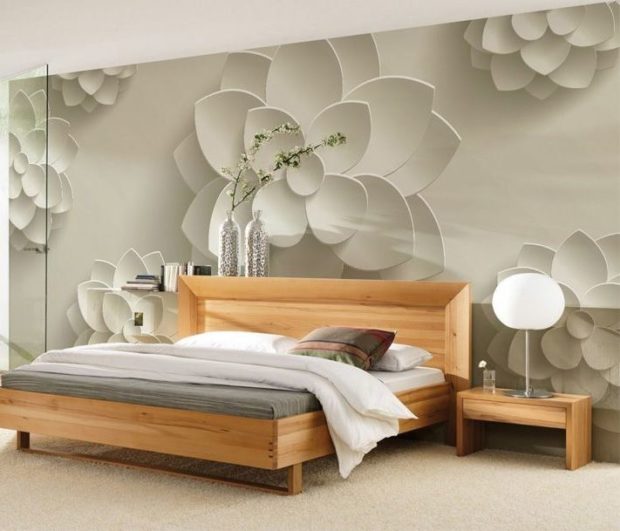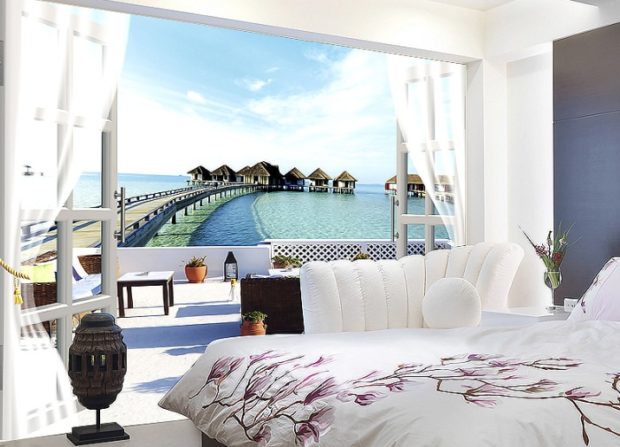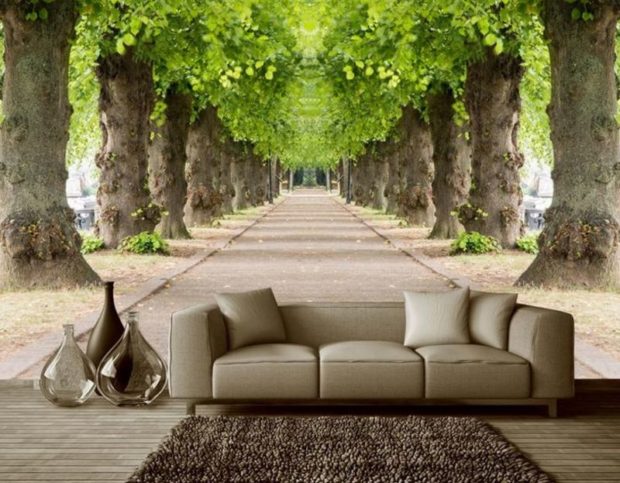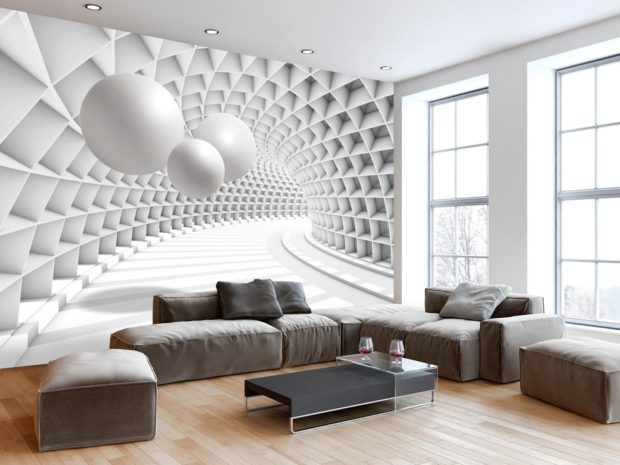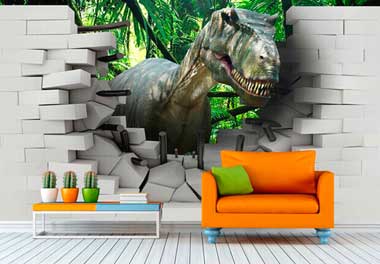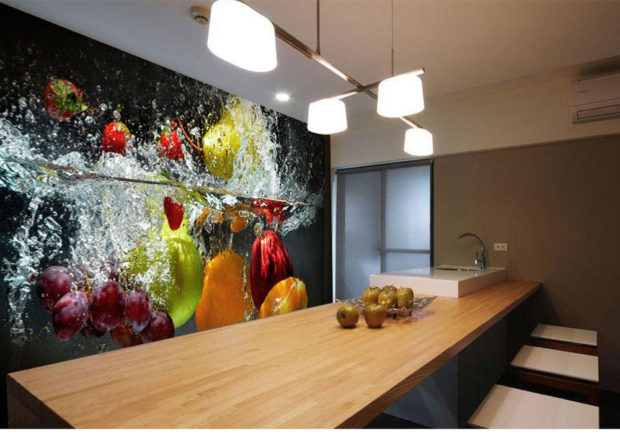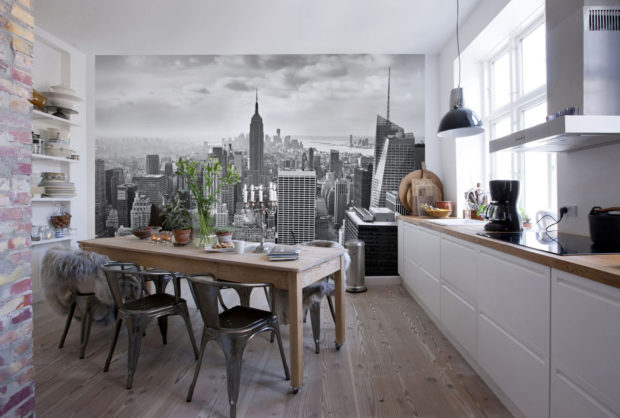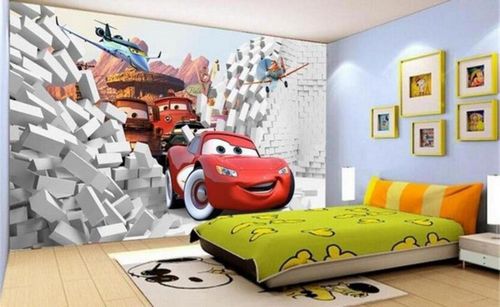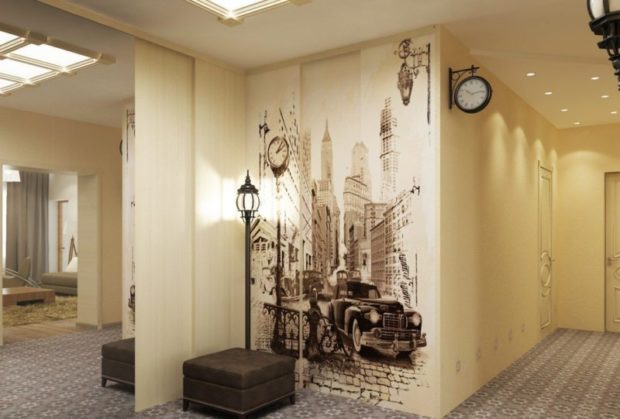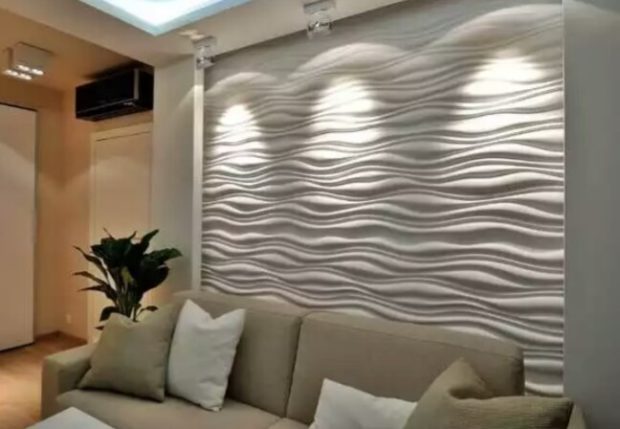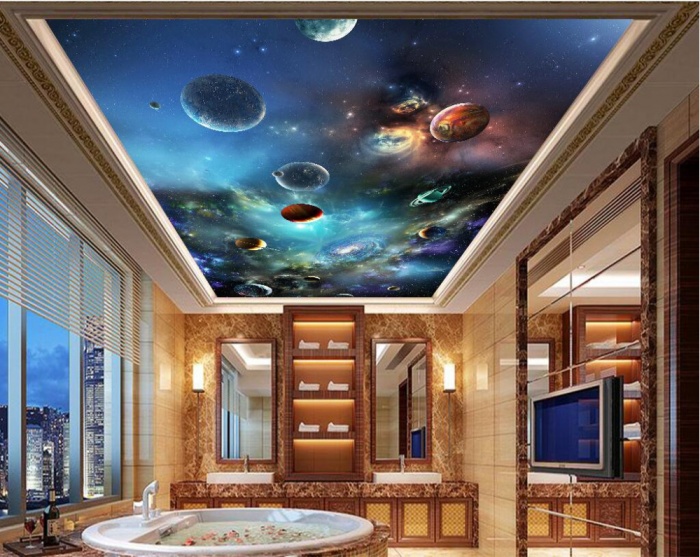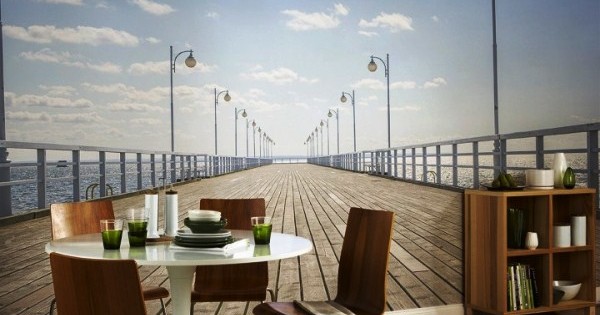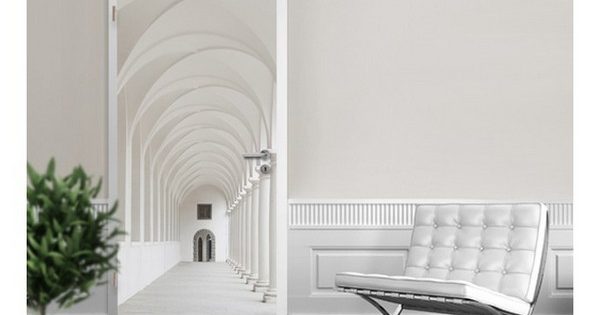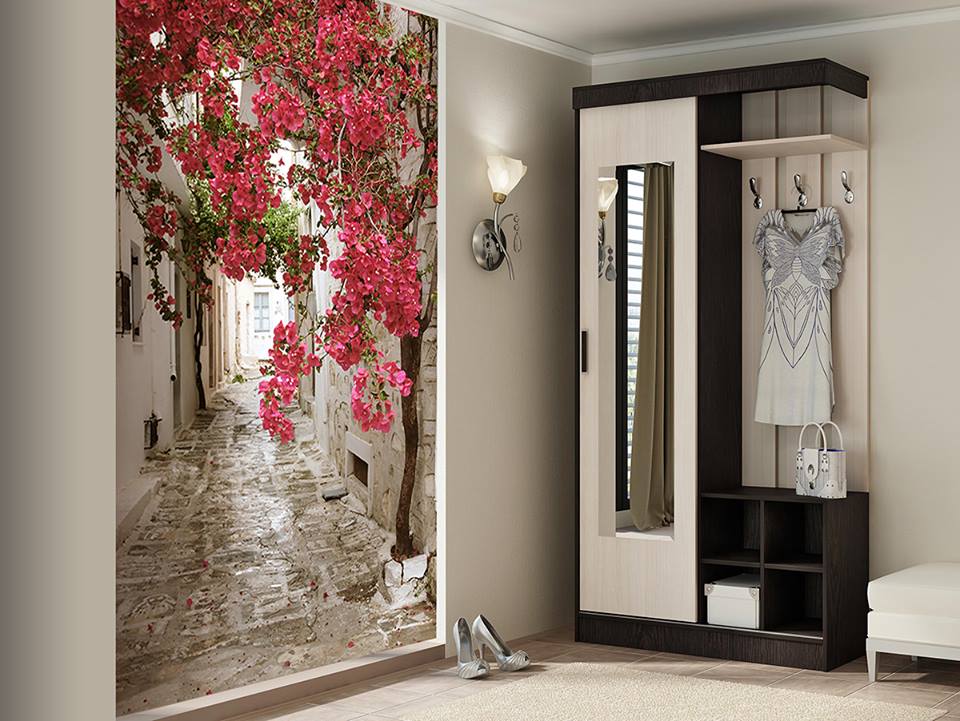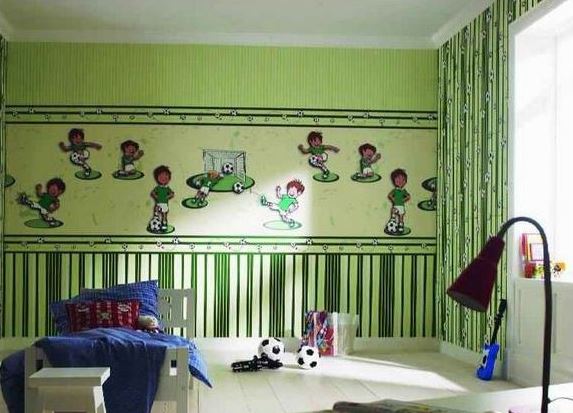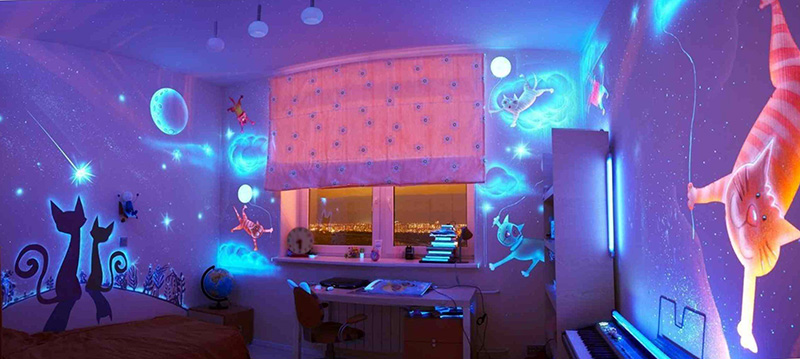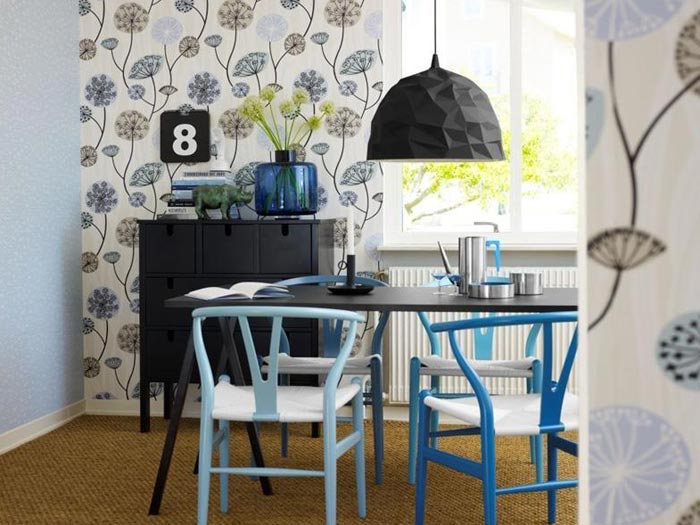3D wall mural in the interior: 8 tips for choosing and using + photo
Surprisingly, photo wallpaper is always at the peak of fashion. Once upon a time, a wallpaper with a picture of a forest or a waterfall was the limit of dreams. Such paper canvases adorned many apartments and organizations. They can not be compared with realistic ones. modern photo wallpaper. But progress does not stand still - a new type of photowall-paper with a three-dimensional image has already appeared. This picture looks voluminous and deep, transforming the room. Previously, such a decoration was available only to the wealthiest people, but now almost everyone can apply such a decoration. It remains only to figure out how to use 3D photo wallpaper in the interior, what they are, and whether they have significant shortcomings.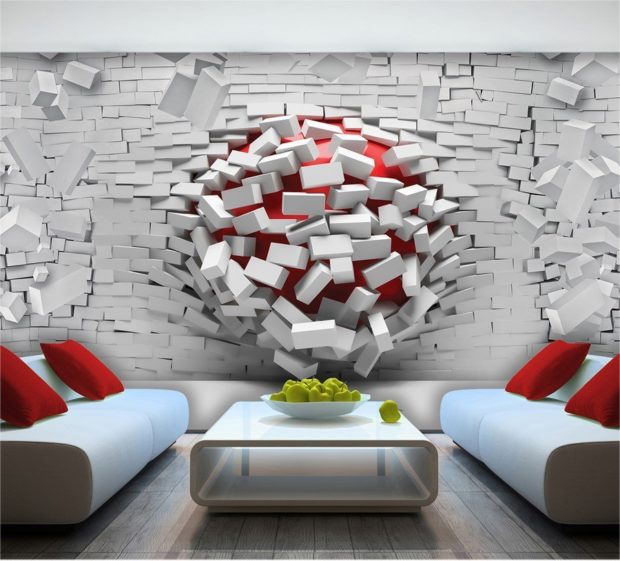
No. 1. How is the 3D effect achieved?
Probably, everyone at least once in his life watched a movie with a 3D effect. There, the image becomes voluminous due to the special technology of creating a film and using glasses. Something like that was done with photo wallpaper, only you will not need glasses. The image on such wallpapers has not only height and width, but also volume and depth. It may create the effect that some object protrudes beyond the wall into the room. Some objects, on the contrary, may seem remote. One part can be perceived as if it is behind another part. In general, the picture comes out voluminous and very realistic.
The effect of three-dimensionality is achieved due to high quality printing, special artistic techniques and image processing in special programs. Classical artistic techniques include black and white drawing, a combination of warm and cold colors, the use of texture elements, linear and tonal perspective. A trick is often used when the central subject is much brighter than the background. Manufacturers use another nuance of human perception of space: objects of warm colors seem to be closer than objects of cold colors.
No. 2. Pros and cons of 3D photo wallpaper
The main advantages of three-dimensional photo wallpapers, for sure, everyone can easily name independently, but this type of decoration boasts some unobvious advantages. To better understand what we are dealing with, we list all the advantages of the material:
- unusual appearance. Three-dimensional murals will definitely become the highlight of the interior, its center and even a way to go into another reality. 3D composition is able to erase the boundaries of space, transform the room, turn it into a part of the sea shore or into a spaceship;
- a huge selection of images, so that even bold interior ideas can be brought to life;
- most of these photowall-paper contains polyester, which increases the wear resistance of the product and gives it resistance to the sun;
- simplicity in leaving as the surface does not attract dust and are easily cleaned. Most products receive a protective vinyl layer that can be wet-cleaned;
- protective treatment allows you to make 3D murals resistant to fire;
- only environmentally friendly materials are used in production, so that such wallpaper can be glued even in children's rooms;
- durability.Finishing will last a long time, unless, of course, you constantly lean on the wall and rub it with brushes.

Minuses:
- cost. Volumetric wallpapers, although they have decreased in price, are still more expensive than ordinary photo wallpapers. If you are planning an economic repair, then such a decoration is unlikely to suit you;
- limited use. 3D murals are better suited for spacious rooms, since they are saturated with pseudo-relief elements. Such wallpapers are more created in order to bring a certain mood into the room, to make it unusual. However, this does not mean that three-dimensional wallpapers are taboo for small spaces. It’s just that in this case the chance to make a fatal mistake is very high and only emphasize the shortage of square meters. You must approach the selection of images wisely. Below we will return to this issue;
- features of perception. Scientists estimate that about 28% of people experience difficulty in contact with three-dimensional images. Within an hour, headaches, dizziness, and nausea may occur. Everyone can be at risk, so before buying it is advisable to check how households perceive three-dimensional pictures. Comparing in 3D films would be wrong - they have a much more aggressive effect. But if you don’t feel sick even when watching such a movie, then the photo wallpaper will certainly take root in the apartment;
- non-repairability. It is impossible to restore a damaged image - you have to re-glue it.
As for the installation features, it’s not very difficult to stick 3D photo wallpaper - the process is about the same as when gluing ordinary photo wallpaper. Only precision and accuracy are needed without rushing.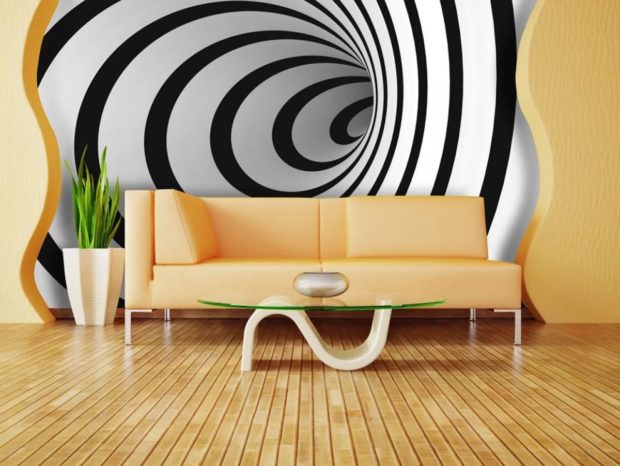
No. 3. Printing method and type of substrate
There are some nuances in the production of 3D photo wallpaper, but the basic principles of manufacturing are similar to those used to create ordinary photo wallpapers. On the basis of the applied drawing, previously created using special programs. In this case, different types of ink and bases are used.
To print three-dimensional photo wallpaper use:
- ultraviolet ink. This is the best choice that allows you to correctly convey all the shades, create contrasting and vibrant wallpapers. Ink polymerizes on the base under the influence of UV rays, and therefore tightly adheres to it. The figure comes out durable, resistant to sunlight, moisture and grease;
- latex ink produced by dissolving paint pigments in latex, due to which the coating quickly hardens. The dye is completely safe for humans, so such wallpapers are used even in children's rooms. The coating is resistant to abrasion, durability and rich colors;
- eco solvent ink produced by dissolving the dye in water. For a person, such a coating is completely safe, although a slight smell may be present - it disappears on the very first day and does not indicate toxicity. Ink has a low cost, resistance to abrasion, washing and ultraviolet, with their help you can print images with the highest resolution.

3D printing requirements increased. Due to the high resolution and special solutions, it turns out to create realistic pictures.
Base for 3D photo wallpaper can be of several types:
- paper - the most environmentally friendly and inexpensive, able to breathe, but inferior to vinyl and non-woven in terms of performance;
- vinyl - more durable, resistant to wet cleaning;
- non-woven - a good option. This material breathes, like paper, but is much stronger and more durable than it is.

Number 4. The main types of 3D photo wallpaper
Depending on the layout method of 3D volumetric drawing, 3D murals can be divided into several types:
- panoramic wallpaper more often are created to order, since it is important to take into account the dimensions of the room during manufacture. They paste over the entire wall with a possible approach to neighboring walls or the ceiling, due to which the effect of maximum realism and dissolution of the borders of the room is achieved.As a rule, panoramic wallpapers are produced in one large roll so that the seams and joints do not interfere with immersion in a new reality. You can’t carry out the installation alone - you must act at least together;

- fragmentary or single wallpaper differ in more modest dimensions, designed to decorate part of the wall. If you enclose them in a decorative frame and properly highlight, you get the most real window with a beautiful view of the forest path, city landscape or the ocean;

- roll wallpaper sold, as you might guess, in rolls. Their difference lies in the nature of the picture. There is no semantic center in it, it is a set of randomly repeating elements, which greatly facilitates the process of gluing and fitting individual bands. Often, such a wallpaper depicts a volumetric cell, satellite images of cities, and abstract drawings. This is the most inexpensive version of three-dimensional photo wallpaper.

Separately, you can consider different options luminous wallpaper (fluorescent and LED)which are equipped with additional elements. While this is expensive news, and the cheaper options are not of high quality.
Fluorescent 3D Wallpaper
Fluorescent murals differ from ordinary 3D murals in that a special paint with a phosphor is applied to their individual parts, which tends to glow under the influence of ultraviolet rays. Contours of objects or individual elements can be highlighted. Particularly spectacular, this backlight looks on images of space and the night city.
Luminous paint can be of different colors, during the day the image is no different about what is done according to standard technology. Phosphor is not white phosphorus. It is completely safe for health and at the same time allows you to turn a room into a fairy tale at night. This substance, by the way, is used in medicine for oncology diagnostics, as well as in the production of banknotes with which we contact daily. So you yourself can judge its harmlessness.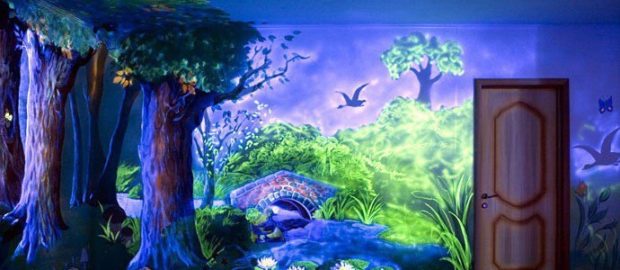
With the onset of night, luminous zones begin to appear on the photo wallpaper, but they are fully manifested in the light of special BLB lamps. They are specially installed near the wall with photowall-paper, sometimes even direct a stream of light in a certain zone. It is interesting that the glow will not be monotonous, but with a different intensity and shade. In addition to this, the image seems more realistic and truly voluminous - this is such a deception.
Do not confuse fluorescent wallpapers with fluorescent ones. The latter use phosphorus-containing paint, it accumulates light during the day and gives off at night, and the intensity of the glow gradually decreases - this will not happen with fluorescent wallpaper. Phosphor-coated wallpapers cause fear in many. The opinion that they are harmful is not unreasonable, but modern products contain a minimal amount of phosphorus, therefore they cannot have a toxic effect - technology does not stand still. On the other hand, it is better not to use fluorescent wallpaper in children's rooms.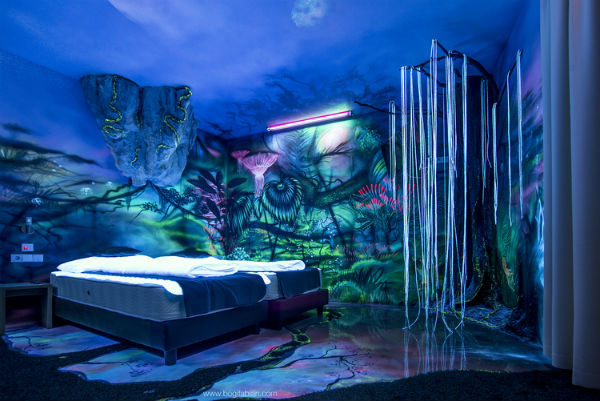
LED 3D Wallpaper
They also glow, but the light comes from the LED coating applied to the canvas. This type of decoration is a cross between wallpaper and panels. Coverage is associated with the control chip, and the one with the remote control. You can turn on the backlight at the touch of a button. The most advanced systems offer several lighting scenarios and allow you to adjust the brightness and frequency of blinking. The more modes, the more expensive the system.
LED wallpapers are rather not wallpapers, but LED panels that stick to the wall like wallpapers. A special LED composition is applied to the canvas, which glows when current flows through it. So the glow is formed. Power is supplied by a wall outlet, conventional or solar panels.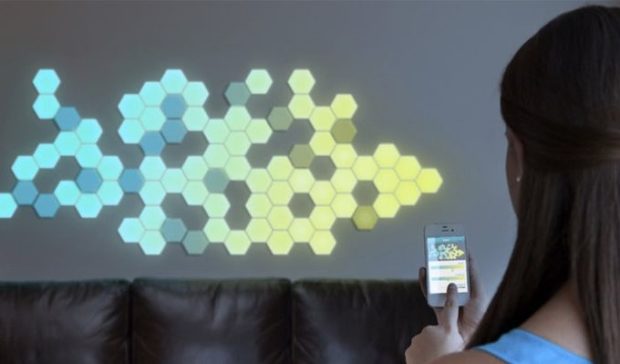
Gluing LED three-dimensional wallpapers is not as difficult as it might seem. It is just necessary to observe the recommended overlap parameter in order to ensure normal contact of the electrical circuit.Installation of large canvases with a complex scheme of work is best entrusted to specialists.
The first such wallpapers appeared in 2006. Yes, this is no longer a concept, but it is still far from mass production. That is why it is still difficult to talk about durability and other operating parameters. Chinese manufacturers decided to take advantage of the empty niche and, to put it mildly, offer low-quality products, so many are not very good at LED wallpapers. In the future, perhaps they will be able to replace conventional lighting devices.
No. 5. Where can I use 3D murals?
To many, this question may seem silly. Where else to use photo wallpaper, except on the walls, but if you include fantasy, you can find some other applications.
3D photo wallpaper can be used:
- for decorating walls and partitions. We will not dwell on this option - everything is clear here. Wallpaper is glued to part of the wall, the entire wall, with approach to adjacent walls. For this purpose any wallpaper is suitable;

- for ceiling decoration. Three-dimensional wallpaper with the image of the starry sky, space, arch of the ancient building will become a decoration of the room. Luminous canvases will look especially successful. It will be difficult to cope with sticking on your own - you have to call specialists;

- for decoration nichesthat will become as much as possible with a chic window;

- for door trim;

- for decoration stairs. If you correctly paste parts of one image onto the risers, you can achieve the effect that you are rising above a waterfall, forest or rocks. The main thing is that the interior should be decorated in a suitable style, and when climbing stairs there would be no comic dissonance;

- for flooring as part of a system of bulk floors. A layer with a three-dimensional image on top is covered with a transparent polymer layer, which protects the drawing itself. You can create a real “wow effect” by turning the apartment into a house located above the seabed. Good solution for bathrooms.



No. 6. How to choose the color and pattern?
3D murals are not only beauty, but also a high risk of making a mistake by choosing the wrong image. The error threatens to distort the perception of the room, i.e. the room may seem smaller than it is. In the worst case, households will not be able to normally stay in a room with three-dimensional wallpaper due to irritation or poor health. In order not to spoil everything, use Designers advice when choosing 3D photo wallpaper in the interior:
- rooms with a small area - an object of increased risk. There should not be any convex and overly voluminous drawings. It is better to prefer a drawing in bright colors with a perspective, it will stretch the room, making it visually more spacious. Light canvases “work” well in shaded areas of rooms, visually pushing back the darker part of the room and relieving pressure;

- for a bedroom and a children's room it is better to choose images with not too active and aggressive patterns, otherwise it will be difficult to stay for a long time in the room. Better that volumetric workers will be larger, and their number will be less;
- it is very important that Wall mural interacted with the interior, were part of it, a logical continuation. Communication should be traced in the decoration, decor, furniture, colors. For example, if an ancient stone staircase is depicted on the canvas, then it can be supported by elements of stone decoration, forging and green plants;
- Wall murals with a glossy surface are better not placed opposite the window, then all their bulk risks being lost, and there will be a lot of glare;
- for large rooms all types of images are suitable, it remains to consider only the nature of the room.
Keep in mind that the true beauty of three-dimensional photo wallpaper can be seen at some distance from them, which is why they are recommended to be used in fairly spacious rooms.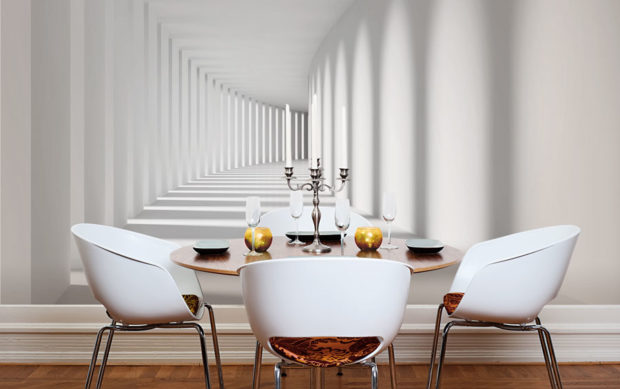
Number 7. 3D photo wallpaper in the interior of different rooms
When choosing photo wallpaper, it is worth considering the type of room in terms of the requirements put forward to it and the prevailing conditions. First of all, this concerns the type of foundation. 3D wallpaper on paper and non-woven basis are well suited for bedrooms and nurseries, as well as for the living room. For the kitchen, hallway and baths can not come up with anything better than a vinyl base.
As for the nature of the image, here everyone has the right to proceed from their own taste, however, so that the room is cozy and comfortable, and I would not want to run away from it as quickly as possible, we recommend taking into account some features of different rooms when choosing:
- for the bedroom images in calm shades are suitable, you can choose flowers, abstraction, sea or forest landscapes, the image of architecture - anything that will not interfere with normal rest. Usually wall murals adorn the wall behind the head of the bed, but this is not the rule, it can be done differently. Color adjacent walls should be close in tone to the color of the photo wallpaper;


- living room - the best field for bold experiments. It is allowed to use bright enough colors with an active pattern. You need to build on interior style. For instance, classics close flowers, still lifes, paintings in the antique style. In style high tech an image of a night city or a black-and-white tunnel going into the distance, cosmic depths or abstraction will fit. Scandinavian style suitable winter panoramas, style provence - boundless lavender fields and French streets. Remember that the 3D wallpaper located in the entire wall is the main detail of the interior, so do not overdo it when furnishing and decorating the room;



- on the kitchen voluminous wallpaper it’s better to decorate the wall near the dining table - beautifully and safely for wallpapers. Warm shades increase appetite, cold shades soothe it a bit, so decide for yourself what you need more. The selection of images is huge. Among the standard ones, wallpapers with vegetables, fruits, coffee beans, wine bottles, cups and dishes can be distinguished - in general, a still life in all its glory. City landscapes also look good in the kitchen, and reproductions of famous paintings are suitable for the classic style - they will look even more exciting in a voluminous form. Immortal classics remain flower arrangements;


- 3D photo wallpaper in the interior of the children's room able to create a magical world that every kid wants to believe in. Canvases with images of cartoon characters who seem to step on the room’s space will look great. Castles and princesses, superheroes, space battles, interesting sea world, pirate ship, starry sky, animals - all this will be appropriate in the child’s room. Pay attention to the fluorescent wallpaper. The nursery should be bright and colorful, but it’s important not to overdo it. Overly saturated colors cannot be used;

- in the hallway and corridor 3D wall murals must be used very carefully. Take plain canvas with a perspective. For example, a colonnade that goes into the distance.

Number 8. How to glue 3D murals?
Ideally, it is better to trust wall murals to professionals. They will properly prepare the walls and cope with gluing even large paintings. If you have some experience in the repair work, and you do not have to glue panoramic wallpapers, but fragmentary or rolled ones, then you can try to cope on your own. The sequence of actions is as follows:
- thorough surface preparation. Old paint and Wallpaper takencracks are cleaned with putties. If serious irregularities, you may need plaster, and if everything is really bad, then it is better to do with sheets of drywall. After careful alignment, the turn comes primers, you can add an antiseptic to it;

- lay out on the floor parts of one drawing or cut parts of a roll. It is better to make the adjustment on the floor, so that in the middle of the work it does not become clear that something does not match.On the wall, you can also mark the places of attachment of the whole canvas or individual stripes of photo wallpaper. Marking is carried out with a pencil using a building level. Gluing will be much easier;

- glue preparation. It's better choose glue for heavy vinyl wallpapers. It is sold in finished form or in powder, which must be dissolved according to the instructions;
- glue is applied to the wall, starting from the lower left corner. Again, panoramic wall murals cannot be mounted alone - only with a partner. Roll the rubber roller over the web to expel air bubbles. If somewhere the bubble remains, then it can be pierced with a needle and gently flatten the canvas. If the wallpaper contains several paintings, then they are glued back to back, but for some types an overlap sticker is provided. It is better to work at a temperature of 18-200FROM.

No special care is required. It is enough to wipe the surface with a dry cloth and sometimes carry out wet cleaning. Finishing will last at least 10 years.

